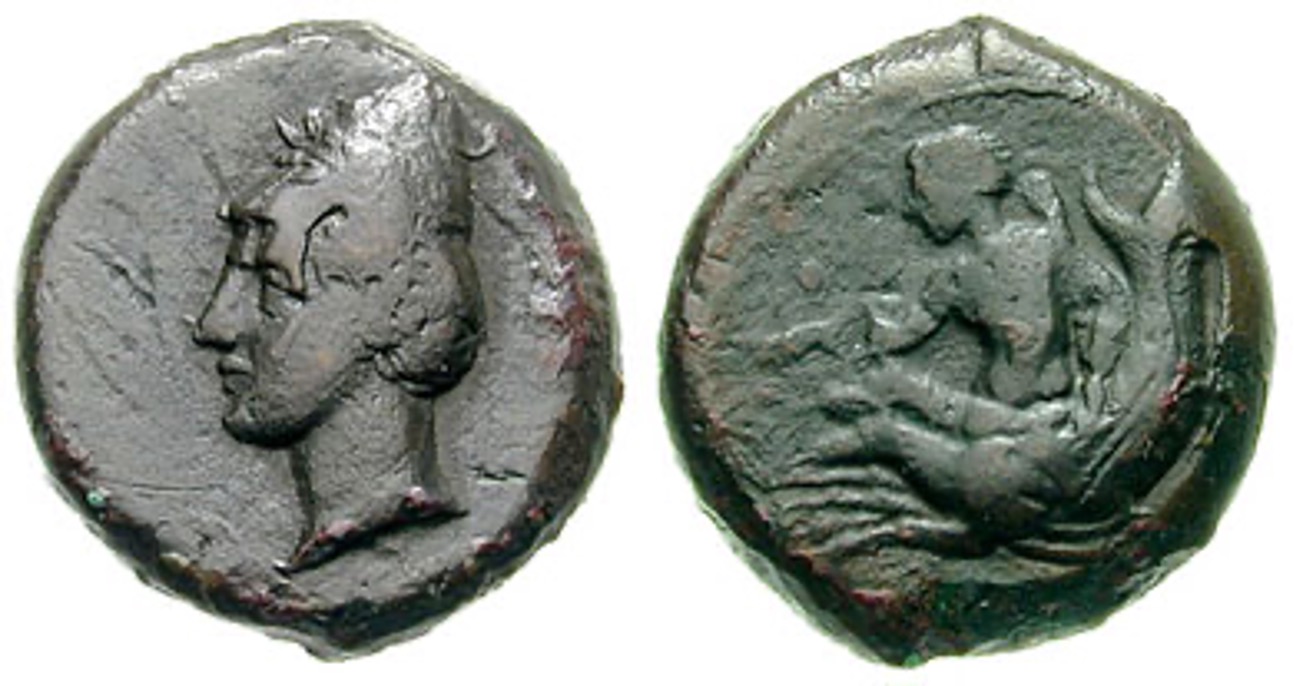SO 1422 - Scylletium over Syracuse
From SILVER
350 BCE - 325 BCE
Location/history
| Sale(s)Sale(s) ᵖ: | Triton 5 (15/01/2002), lot 193 | |
Overstriking coin
Description
| ObverseInscription or printing placed on the obverse.: | Male head left, wearing laureate pileus. | ReverseInscription or printing placed on the reverse.: | Skylla riding left on two dogs-fishs, holding club. Linear border. |
Mint and issuing power
| MintIdentifies the place of manufacture or issue of a numismatic object.: | Scylletium | Ancient regionAncient region. | Magna Graecia (Bruttium) | Modern countryModern country: Italy | AuthorityIdentifies the issuing power. The authority can be "pretended" when the name or the portrait of X is on the coin but he/she was not the issuing power. It can also be "uncertain" when there is no mention of X on the coin but he/she was the issuing power according to the historical sources: |
Chronology
| FromIdentifies the initial date in a range assigned in a numismatic context. 350 BCE toIdentifies the final date in a range assigned in a numismatic context.. 325 BCE | Classical 480-323 BC |
Physical description
| MetalThe physical material (usually metal) from which an object is made.: Bronze |
WeightWeight of the numismatic object (in grams). in grams: 8.628.62 g <br />8,620 mg <br /> | ||
References
| Coin referenceReference of the Coin: | Coin series referenceReference to coin series study: | SNG Copenhagen/Sylloge Nummorum Graecorum: The Royal Collection of coins and medals1SNG Copenhagen/Sylloge Nummorum Graecorum: The Royal Collection of coins and medals, Danish National Museum (43 vols), 1942-1979, n° 1992-1993., HN Italy2HN Italy, n° 2565, HGC 13HGC 1, n° 1722 |
Overstruck type
Description
| ObverseInscription or printing placed on the obverse.: | Athena | ReverseInscription or printing placed on the reverse.: | Hippocamp (visible on obverse: tail on pileus) |
Mint and issuing power
| MintIdentifies the place of manufacture or issue of a numismatic object. ᵖ: | Syracuse | Ancient regionAncient region. ᵖ | Magna Graecia (Sicily) | Modern countryModern country: Italy | AuthorityIdentifies the authority in whose name (explicitly or implicitly) a numismatic object was issued. ᵖ: |
Chronology
| FromIdentifies the initial date in a range assigned in a numismatic context. toIdentifies the final date in a range assigned in a numismatic context.. | periodTime period of the numismatic object. |
Physical description
| DenominationTerm indicating the value of a numismatic object. Examples: tetradrachm, chalkous, denarius. ᵖ: | litra |
References
| Coin type referenceReference to coin series study ᵖ: | Calciati II pg. 874Calciati II pg. 87, 42 |
Additional data
| Frequency of overstrikesFrequency of overstrikes: | Level of confidenceLevel of confidence of the identification: | ||
| RemarksRemarks: | Appears to be overstruck on a Syracusan litra, Athena/Hippocamp (Calciati II pg. 87, 42), with a trace of the hippocamp's tail visible on the pileus. | ||
References
- ^ SNG Copenhagen/Sylloge Nummorum Graecorum: The Royal Collection of coins and medals
- ^ Rutter N. Keith et alii (eds.) (2001), Historia Numorum Italy, London, xvi, 223 p., 43 pl.
- ^ Hoover, Oliver D. (2018), The Handbook of Greek Coinage Series, Volume 1. Handbook of Coins of Italy and Magna Graecia, Sixth to First Centuries BC., Lancaster-London, 2018, lxi, 527 pages, 23 cm
- ^ Calciati II pg. 87
